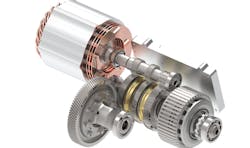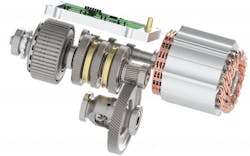Scalable E-drive Integrates Multi-Speed Transmission
The following article was originally published in eeNews Automotive. It is reprinted here with permission.
Today's electric drives are usually designed without transmission; at the most, they may include a reduction gear to lower rpm speed. In addition, the absence of a gearbox makes the drive units simpler and thus more robust and cheaper. They are also more compact than a unit with a transmission.
Ricardo's engineers took exactly the opposite approach when developing their scalable electric drive unit (EDU). The unit is intended to provide state-of-the-art power and torque density as well as system efficiency, and all of that with high noise, vibration, and harshness (NVH) performance.
Why did Ricardo's engineers choose such an adversarial approach? “A multi-speed transmission is clearly more costly than a single speed unit, but it's use can give benefits in terms of weight reduction and more compact sizing of the electric motor, improved whole system cost, energy efficiency, and a hence the potential for a reduced battery size or extended range”, explained a company spokesperson. He was convinced that “the use of multi-speed EDUs is likely to be an increasing trend in the market in the coming five years.”
Engineering company Ricardo introduced a drive unit for electric vehicles that breaks with today's design principles in many respects. Thus, the drive unit should scale better and be more compact and lighter than current designs.
To achieve their goal of a more compact form factor despite the additional effort, the EDU comprises a number of innovative features. The hairpin electric motor has active oil jets on the end windings, with no requirement for back-iron cooling. The integrated inverter is also oil-cooled with direct jet cooling on the back of the IGBT, with the same oil being used for all elements - cooling and lubrication of reducer, electric motor, and inverter.
Further innovations in the transmission include opposed actuation of the two clutches of the dual-clutch transmission to limit load on shaft bearings and enable smaller bearings and less frictional losses as well as other design features to improve transmission efficiency.
The concept of using a single EDU to control the inverter, transmission, and motor is also new. The unit includes advanced thermal-management control, including real time embedded MPC (model predictive control), which offers the prospect of EV range improvements.
The spokesperson also highlighted the fact that the development work of the EDU is continuing. The company plans to present an update on this work at the Berlin CTI in December.
About the Author
Christoph Hammerschmidt
Christoph Hammerschmidt is an electronics engineer and technology journalist. He is the editor of EETimes.de.


